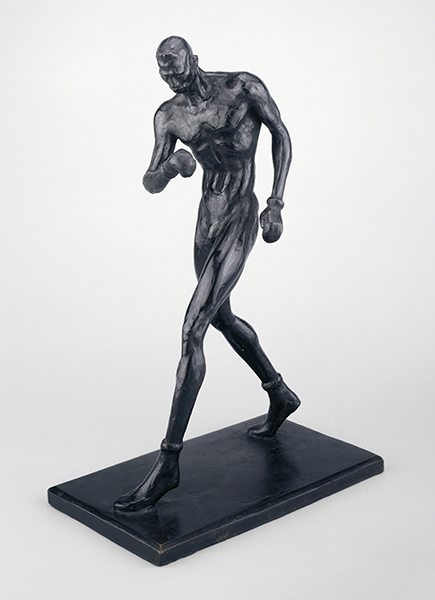LGBTQ+ History Month: Richmond Barthé
I think it is important to always keep in mind that LGBTQ pride did not “begin” with the Stonewall Riots of 1969—a series of protests by members of the gay community in response to an unprovoked police raid on June 28, 1969, at the Stonewall Inn, a gay bar in Lower Manhattan. Also, being “gay” is not an invention or fad of the late 1900s but has been part of humanity since we started walking upright. There have been many, many, many artists throughout history who were gay, and who were equally as diverse, fascinating, and significant to the history of art as every other artist. Richmond Barthé was an African American artist who was a significant sculptor of the Harlem Renaissance (ca. 1920s–1930s).
 |
| Richmond Barthé (1901–1989, U.S.), The Boxer, 1942. Bronze, height: 18 ¾" (47.6 cm). Courtesy of the Art Institute of Chicago. © 2022 Artist or Estate of Artist. (AIC-291) |
During the 1930s, Barthé came to emphasize the male nude as a central theme of his production, the only African American sculptor of his generation to do so. Unlike his contemporaries who emphasized African American themes in a modern visual vocabulary, Barthé’s work was firmly rooted in traditional academic sculpture, although his realistic depiction of male anatomy lent his work a bold expression.
Unlike the ancient Greek sculptors who emphasized the “ideal” male form in sculpture, Barthé's figures emphasize grace and elegance rather than a Westernern idea of the perfect human physique. Barthé relied on memory for the figure of the boxer, recalling a Cuban boxer he had seen in Harlem called Kid Chocolate (Eligio Sardinas Montalvo, 1910–1988), whose graceful moves reminded Barthé of a dancer rather than a macho athlete. That is very much evident in the artist's emphasis on his slender form and feet seemingly in mid-movement.
After World War I (1914–1918), there was a great migration of African Americans from the rural South to cities in the North. Although African American men had served in the war, racial prejudice, segregation, and lack of opportunity in the South continued to deny African Americans the hope of fuller participation in society. Black people looked to big cities and the broader range of jobs in the industrial North in the hope of a better life.
In cities such as New York and Chicago, cohesive African American communities formed within the cities, and African Americans found a new self-awareness and pride in their heritage. During the 1920s, a significant number of artists were brought together within these large and varied African American communities, something that could not have happened in the rural South. One of the most vital African American communities was in the Harlem neighborhood of New York.
Barthé was born in Mississippi, where he first made pictures as a child by copying typography and photographs from newspapers and magazines. His first exposure to fine art from Europe came while he worked for a wealthy family in New Orleans. As his artistic tastes matured, he found inspiration in movements from the 1800s such as Romanticism and Neoclassical painting.
Because schools in the South at the time did not train African American artists, in 1924 Barthé moved to Chicago. The city had a vibrant Black artist community, mostly on the South Side. These artists banded together during the Great Depression (1929–1940) to form the Art Craft Guild (1932), providing art lessons from the School of the Art Institute to many future prominent African American artists. Around 1937, the South Side Community Arts Center was founded with backing by the Federal Arts Project.
Barthé studied painting at the School of the Art Institute of Chicago and privately with Archibald Motley, Jr. (1891–1981). Although he considered himself a painter, Barthé first gained public attention when he submitted portraits in clay to a landmark show at the Art Institute called The Negro in Art Week in 1927. Because of the success of his clay works, Barthé gradually abandoned painting and concentrated on sculpture for his career. Barthé moved to Harlem in 1929 and immediately surrounded himself by the prominent African Americans of the Harlem Renaissance, including the famous Alain Locke (1885–1954).
Correlations to Davis Program: Explorations in Art 2E Grade 1: 2.4; Explorations in Art 2E Grade 2: 5.7; Explorations in Art 2E Grade 3: 1.6; Explorations in Art 2E Grade 4: 2.3; The Visual Experience 4E: 6.10, 7.6; Experience Art: 6.2; Exploring Visual Design 4E: pp. 232-235


Comments